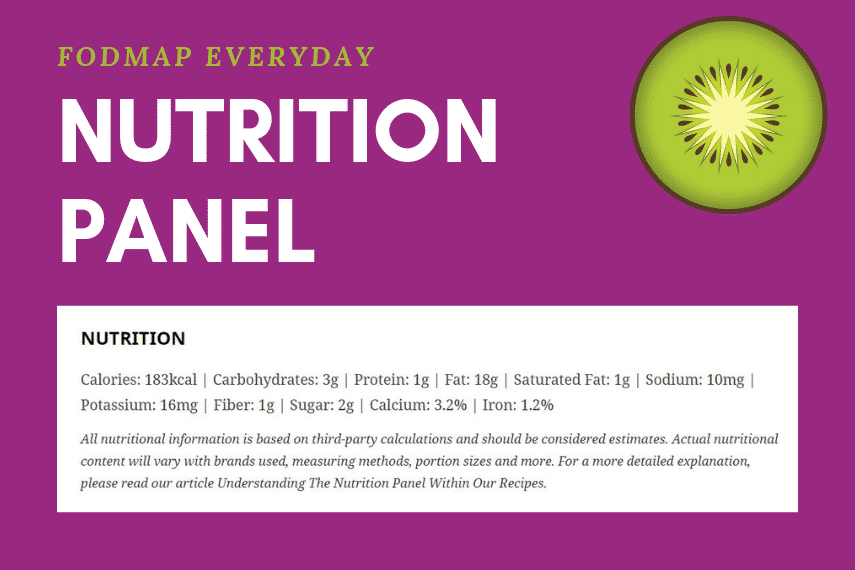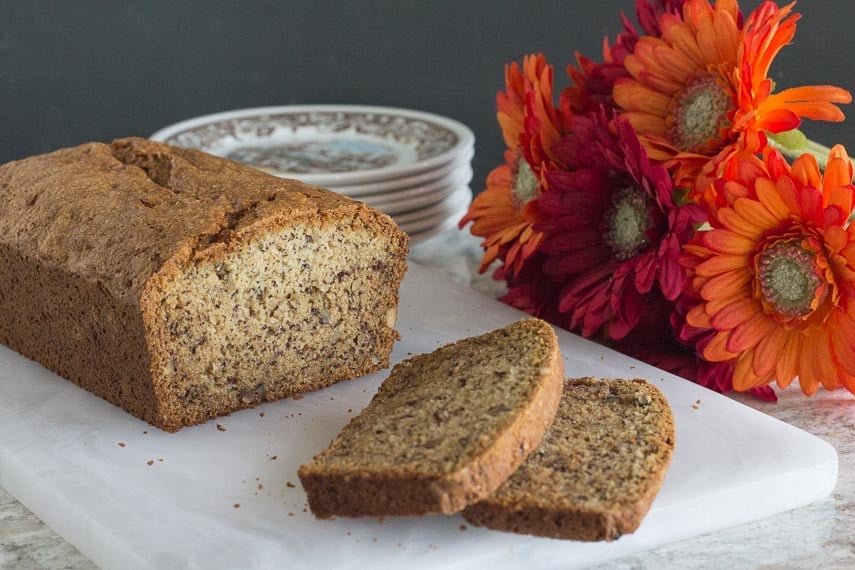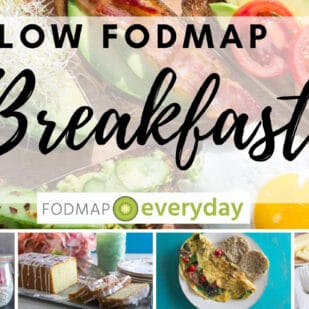Understanding The Nutrition Panel Within Our Recipes
FODMAP Everyday®did not launch with nutritional information attached to our recipes for some very specific reasons. We are featuring them now, also for very specific reasons and we would like to explain our process.
The Low FODMAP Diet Is Complex
The low FODMAP diet is complex and nuanced and we have found that it can be quite challenging for people, especially those new to the diet.
A main goal behind the low FODMAP diet is to address your IBS symptoms through a series of carefully orchestrated steps – all of which focus on the levels of FODMAPs within raw and prepared food products.
The low FODMAP diet does NOT focus on calories, sodium, fat, sugar intake or anything other than FODMAP content.
Nutrition panels DO focus on calories, fat, vitamins and minerals and a host of other details that are outside of the main purview of the low FODMAP diet.
Very often a Registered Dietitian will work with you on FODMAP levels as well as “healthy eating guidelines”. In this case the nutritional info within our recipes might be of service.
Lack of Accuracy of Nutritional Information
The information within the nutritional panels is approximate. The values should be considered estimates.
This is due to several factors including how ingredients are measured and reported and also what food calculations are represented in the third-party databases that provide information for the nutritional panels.
The technical aspects of this are easy to explain. For instance, 1 medium banana in a database will have certain amounts of calories, fiber and carbohydrates attributed to it, but those are not necessarily the same contained in the banana that you just used in our Low FODMAP Banana Bread.
Your bananas might be a little larger or smaller, therefore not matching what was lab tested and entered into the database.
Vegetables and Fruits
Vegetables and fruits are natural products and one is never exactly like another. Where and how they are grown, and when they are harvested and how they are stored ALL affect their nutrition.
Yet there is only one set of numbers attributed to a medium banana in the databases.
Fruit and vegetables have a common problem in that many recipes will call for, and the calculator will notate, a certain amount of the ingredient, but during prep the produce is trimmed and the weight of the food that actually ends up in your dish – and your GI system – is less, sometimes dramatically so.
Stems and other discarded parts of fruits and vegetables can be heavy.
And as you can imagine, no databases that we know of have the nutritional information for scallion greens or leek greens only, which is an issue since we use them so often.
Prepared Products
Prepared products have the same problem, but for different reasons. 1 cup (240 ml) of marinara sauce will have a set of numbers attributed to it in a database, and yet the marinara sauce you are using will most likely contain different ingredients. In fact every commercially prepared marinara sauce has a different formulation.
The databases used have but one representation of marinara sauce. As examples, some marinara sauce formulations contain sugar; some do not and sodium levels vary widely from brand to brand. Some contain fat and others none at all. Again, consider these values within the nutritional section to be approximate.
Pancake and waffle recipes will often recommend a range of liquid, such as using 1 cup (240 ml) to 1 ½ cups (360 ml) lactose-free whole milk to create the desired batter texture. Nutritional calculators cannot take ranges into consideration.
And speaking of pancakes and waffles, directions often suggest to serve them with maple syrup. The maple syrup is, in theory, optional and if used the amounts will be individual. The nutrition listed does not take the maple syrup into account.
Salt and Pepper
Certainly, if sodium is a concern for you, please recognize that the values given are far from precise. One of our goals is to teach you how to cook. Recipe directions will often suggest “season to taste”.
When it comes to salt and pepper the amount that ends up in your dish will be unique and cannot be accounted for within our nutritional information.
Recipe Yields, Usage and Varied Serving Sizes
Please pay attention to cookie yields. If a cookie recipe yields 24 cookies and a serving size is 1 cookie, then the approximate nutritional info is based upon this yield. If you end up with 18 cookies, making them much larger than recommended, or even if you make them smaller and end up with 30 cookies…either way the nutritional info will no longer be applicable.
Ditto for slices of cake. If we say a cake yields 10 slices, pay heed to the number.
Probably one of the biggest issues I see is with dressing, sauces and marinades, where the nutritional panel is calculating the entire amount of ingredients represented in the recipe, yet I am directing you to only use a partial amount.
Sometimes this is deliberate on my part as a recipe developer, so that you have leftovers. Sometimes you end up using only a portion of the sauce/marinade because of the variability with absorption from the first time you make the recipe to the next.
And very often you use an amount of marinade and discard most of it after your protein or vegetables (or what have you) are finished marinating. The nutritional panels cannot and do not take this partial usage into account.
People – And Google – Want Nutritional Information
Occasionally we have received requests for nutritional information, and up until now we have explained that our focus is on the low FODMAP diet and that we had chosen not to offer this information – also because we knew the information is far from perfect.
We are largely a digital platform and we are dedicated to bringing you the kind of low FODMAP information you can use, including recipes.
Google is now penalizing sites and blogs that present recipes if they do not provide nutritional information. We found ourselves caught between a rock and a hard place. Penalties from Google would ultimately negatively affect the way our community interacts with our site.











My question is how much is the serving size for the low FM eggplant parmesan? I agree in that I don’t need to count calories, but I’m supposed to keep track of my carbohydrates in grams.
Hi Lynn, I am not sure I understand your question as the nutritional panel within that recipe does state 28 g per serving. Is there something else you wanted to know?
Hey, I failed to find info regarding the serving size in the nutritional panel. For example, here (https://www.fodmapeveryday.com/recipes/low-fodmap-tuna-salad/) I read that there’s 279 kcal in the salad. I read there’s 6 servings. So, it’s 279 kcal per serving? If so, what’s the serving size? 30g, 100g, 250g?
Or is it always calories per 100g?
Thank you for your work, the recipes are lovely!
The recipe makes 6 servings. The nutritional panel represents 1/6th of the whole. Certain recipes such as a roast beef would be presented the same way – “serves 10” etc. Others have more precise info such as 2 tablespoons of a salsa.